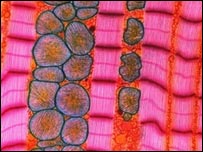| ||||||||||||||||||||||||||||||||||||||||||||||||||||||||||||||||||||||||||||||||||||||||||||||||||||||||||||||||
|
Scientists have found a way to block the genetic1 flaw that causes the most common form of muscular dystrophy. 科学家已经发现一种阻止由基因缺陷引起的普通型式的肌肉萎缩的方法。  The diseases cause muscle weakness and wasting Tests on mice found injecting them with a compound that neutralises(中和) the faulty gene2's activity led to muscle cells working more effectively. The US team's work, published in Science, could be a step towards treatments to reverse the symptoms of the disease. UK experts said the study results were "exciting". Around 7,500 children and adults in the UK have some form of muscular dystrophy(肌肉萎缩症). Myotonic dystrophy(肌强直性营养不良), like other forms of the condition, causes muscle weakness and wasting that is usually progressive. It typically affects muscles in the face, jaw3 and neck. Another symptom is muscle stiffness - myotonia - which tends to be seen in the hands. The condition can appear at any age, and currently there is no treatment that can halt its progress. It is caused by a mutation4(变化,转变) of a specific gene on chromosome5 19. Sticking Scientists discovered RNA - which takes genetic messages from the nucleus6 to the rest of the cell in order to build proteins - was key to myotonic dystrophy. Each gene produces its own RNA. But in myotonic dystrophy, the genetic defect leads to production of a toxic7 RNA which blocks certain proteins from carrying out their normal functions by sticking to them like Velcro. In this study scientists from the University of Rochester in New York found the blocking of a protein called "muscleblind" causes the characteristic hand stiffness. The toxic RNA accumulates(积聚,堆积) as deposits which are visible in the cell's nucleus(核心,原子核). The team used a synthetic8(合成的,人造的) molecule9(分子), called an antisense(反义) morpholino(玛琳代) oligonucleotide(低核苷酸), that mimics10(模仿的,假的) a segment of the genetic code to break up these deposits and re-establish cellular11 activity. It was specifically designed to bind12 to the toxic RNA and neutralise its harmful effects. When it was injected into the muscle cells of mice with myotonic dystrophy, the stuck proteins were released and resumed their normal function. The abnormal electrical (myotonic) activity went away. Sticking Neurologist Dr Charles Thornton, who led the research, said: "This study establishes a proof of concept that could be followed to develop a successful treatment for myotonic dystrophy. "It also demonstrates the potential to reverse established symptoms of the disease after they have developed, as opposed to simply preventing them from getting worse." But he said: "Caution is necessary in applying this conclusion directly to people, however, because the muscle disease in the mice is less severe that it is in people with myotonic dystrophy. And he added: "We haven't corrected the underlying13 gene abnormality. What we've done is made it behave in a more mannerly fashion." The researchers say much more research into how the compound could be given and what the side effects might be before it can be tested on humans. But Dr Marita Pohlschmidt, director of research for the UK's Muscular Dystrophy Campaign, said: "These results are exciting as they are a step towards finding a treatment for the 7,500 children and adults in the UK living with this devastating14(破坏性的,全然的) condition. "The challenge now is for scientists to further develop this potential treatment so that it can be tested in clinical trial." 点击  收听单词发音 收听单词发音
|
||||||||||||||||||||||||||||||||||||||||||||||||||||||||||||||||||||||||||||||||||||||||||||||||||||||||||||||||
- 发表评论
-
- 最新评论 进入详细评论页>>



